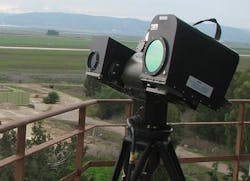Wanted: electro-optics companies able to build multispectral sensor for persistent surveillance
Officials of the Army Contracting Command at Aberdeen Proving Ground, Md., issued a sources-sought notice on Tuesday (W909MY-19-R-E001) for the EO/IR Sensor Characterization for Persistent Surveillance System - Ground (PSS-G) component of the Army's Ground-Based Operational Surveillance System (Expeditionary) (G-BOSS(E)) project.
Army researchers want to find companies able to design a gimbal-mounted integrated electro-optical sensor payload that blends mid-wave and short-wave infrared sensors, laser range finder, and laser pointer.
The Army Contracting Command is issuing the sources-sought notice on behalf of the Product Management Force Protection Systems segment of the Army Night Vision and Electronic Sensors Directorate (NVESD) at Fort Belvoir, Va., for this electro-optical sensor project.
Related: Arete moves forward on multispectral UAV sensor payloads to find mines on invasion beaches
From industry, the Army wants to the know the maximum range of each sensor in the integrated electro-optical sensor payload at a standard atmosphere in which a human and vehicle can be identified with 90-percent probability.
Researchers also want to know about the zoom field of view of each persistent surveillance sensor; imagery and video standards to which the sensor conforms; integrated sensor packaging; whether it has an active illuminator; cooling methods; spectral ranges; hardware control and data interfaces; system size and weight; levels of ruggedization; cyber security standards; built-in test; and reliability, availability, and maintainability.
A multispectral sensor captures image data in 3 to 15 separate wavelengths to extract information the human eye fails to capture with its receptors for red, green and blue. It usually provides a combination of imaging in the visible-light, near infrared, short-wave infrared, mid-wave infrared, and long-wave infrared spectral bands into one image.
Related: Navy eyes 360-degree multispectral persistent surveillance for ship defense
The military typically uses multispectral sensors for target tracking, land mine detection, ballistic missile detection, and space-based imaging.
Companies interested should email responses no later than 16 Oct 2018 to the Army's Crystal Pressley, contract specialist, at [email protected].
For questions or concerns contact the Army's Crystal Pressley by email at [email protected], or by phone at 703-704-0860.
More information is online at https://www.fbo.gov/notices/938d0006915990c918b9da7e46c2b8ca.
Ready to make a purchase? Search the Military & Aerospace Electronics Buyer's Guide for companies, new products, press releases, and videos

